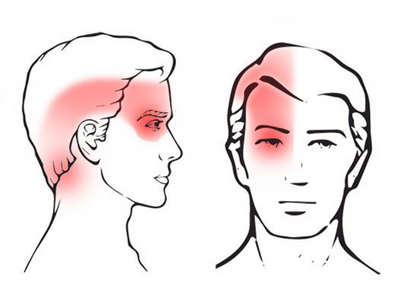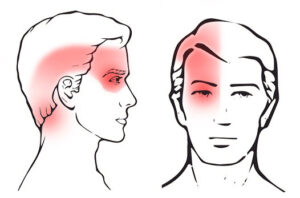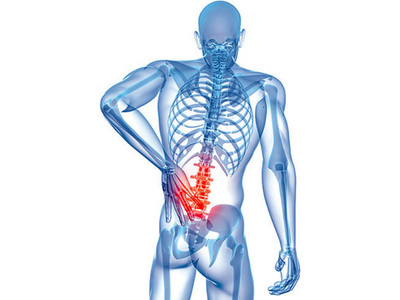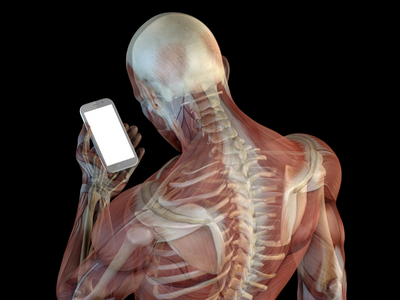A physiotherapists approach to headache has been suppressed or ignored for long . in this article I intend to educate you how u can solve your headache or vertigo issue just with physiotherapy
Headache is a symptom of diseases or a disorder of many origins in the body including the brain, the wiring (nerves), vessels carrying blood, eyes, ears, sinuses, nose and throat, dental and psychiatric as well. Successful management will only be achieved by a successful diagnosis.
The reason that differentiation is often a difficult process is because the health care provider must rely on the nature and pattern of headache and furthermore the symptoms of different causes of headache overlap or the patient may be suffering from more than one form of headache simultaneously.
In such cases, it would be necessary to distinguish between types of headache and determine how much of a role the structures of the cervical spine have in the cause of the headache.
There are 6 different types of headaches:-
- Cervicogenic Headache
- Tension Headache
- Migraine
- Cluster Headache
- Neural Headache
- Post traumatic Headache
Physiotherapy can help resolve all those headaches to some extent and can provide a complete cure to cervicogenic headache.
Symptoms:-
What findings would you expect for cervicogenic headaches?
1. Area:
– frontal, occipital, retro-orbital, temporal
– there is often associated neck pain (sub-occipital)
– symptoms usually start in neck, sub-occipital or occipital
– they are usually unilateral, may be bilateral but does not change sides during attacks. (ie. Starts on one side then spreads to the other)
2. Quality:
– an ache or dull boring pain is the most common description
– can have shooting pain (deep)
– moderate to severe level
3. Associated Symptoms:
– nausea, vomiting and photophobia (ipsilateral to side of pain)
– dizziness
– light-headedness
– visual disturbances
– tinnitus
4. Frequency and duration:
– can be episodic (few hours to few days) or chronic (semi-continuous
or 2-3 per week
5. Time and Mode of onset:
– may be present upon waking and may worsen as day goes on/
activity dependent
6. Aggravating and relieving factors:
– sustained neck postures or movements
– may not know particular pattern
-stress or tension may increase headache
7. General Medical History:
– no family history
– more common from 20-50 age group
– females > males
8. History of onset:
– trauma or degenerative joint disease of upper cervical joints
Management:-
The Physio treatment is focused on the following goals:-
- Improve neck/ upper back mobility
- Improve neural mobility
- Correct muscle imbalances around cervical/shoulder/shoulder blade
- Improve posture
What research says about effect of physio treatments on different kind of headaches:
- There were no differences in headache-related and demographic characteristics between the groups at baseline. The loss to follow-up evaluation was 3.5%. At the 12-month follow-up assessment, both manipulative therapy and specific exercise had significantly reduced headache frequency and intensity, and the neck pain and effects were maintained (P < 0.05 for all). The combined therapies was not significantly superior to either therapy alone, but 10% more patients gained relief with the combination. Effect sizes were at least moderate and clinically relevant
It means that for cervicogenic headaches the physio treatment both manipulations and /or exercises were effective . they were helpful not only for short term relief but for long term as well
- Migraine research review- For the prophylactic treatment of migraine headache, there is evidence from a high-quality study that spinal manipulation may be an effective treatment option with a short-term effect similar to that of a commonly used, effective drug (amitriptyline). There were fewer side effects associated with spinal manipulation.
It means that for short term relief of migraine you can also resort to physio treaments instead of medications.
- For the prophylactic treatment of cervicogenic headache, there is evidence from a high-quality study that both neck exercise (low intensity endurance training) and spinal manipulation are effective in reducing headache intensity and frequency in the short and long term in comparison to no treatment. Except for reduction in headache duration, there is no advantage to combining the two therapies. From two more high-quality studies there is evidence that spinal manipulation is effective in the short term in improving pain and other secondary headache outcomes in comparison to massage or placebo spinal manipulation. Weaker evidence from a lower-quality study showed that spinal manipulation was more effective for pain reduction in the short term than spinal mobilization or no treatment.
It means that specific and low level physio treatments can be used to prevent development of such cervicogenic headaches. The effects are much superior to just massage and/ or chiropractic treatments.
- There is some evidence that spinal mobilization may have better short-term reduction in pain intensity than cold packs in the treatment of post-traumatic headache.
It means that manual therapy is more effective than just cold packs in a headache caused due to some kind of trauma.
Exercises for cervicogenic headache
Although most clients require hands on treatment, in the wake of pandemic we have posted few simple exercises to relieve headache on our youtube channel. try these!!
Conclusion:-
Headaches of cervical origin, migraines, neural type as well as post traumatic types can be benefited by Physiotherapy.
References
- A Randomized Controlled Trial of Exercise and Manipulative Therapy for Cervicogenic Headache
Jull, Gwendolen, PT, PhD,*; Trott, Patricia, PT, MSc,†; Potter, Helen, PT, MSc,‡; Zito, Guy, PT, Grad Dip Manip Ther,§; Niere, Ken, PT, Mph,∥; Shirley, Debra, PT, BSc,¶; Emberson, Jonathan, MSc,#; Marschner, Ian, PhD,#; Richardson, Carolyn, PT, PhD*
Spine: September 1, 2002 – Volume 27 – Issue 17 – p 1835-1843 https://journals.lww.com/spinejournal/Abstract/2002/09010/A_Randomized_Controlled_Trial_of_Exercise_and.4.aspx
- Non-invasive physical treatments for chronic/recurrent headache
Gert Brønfort1 , Niels Nilsson2 , Mitchell Haas3 , Roni L Evans1 , Charles H Goldsmith4 , Willem JJ Assendelft5 , Lex M Bouter6
http://dare.ubvu.vu.nl/bitstream/handle/1871/27456/271236.pdf?sequence=2
- Cervical Headache: A Review. In: Grieve: Grieve’s Modern Manual Therapy of the Vertebral Column. Jull G.A. (1994)





